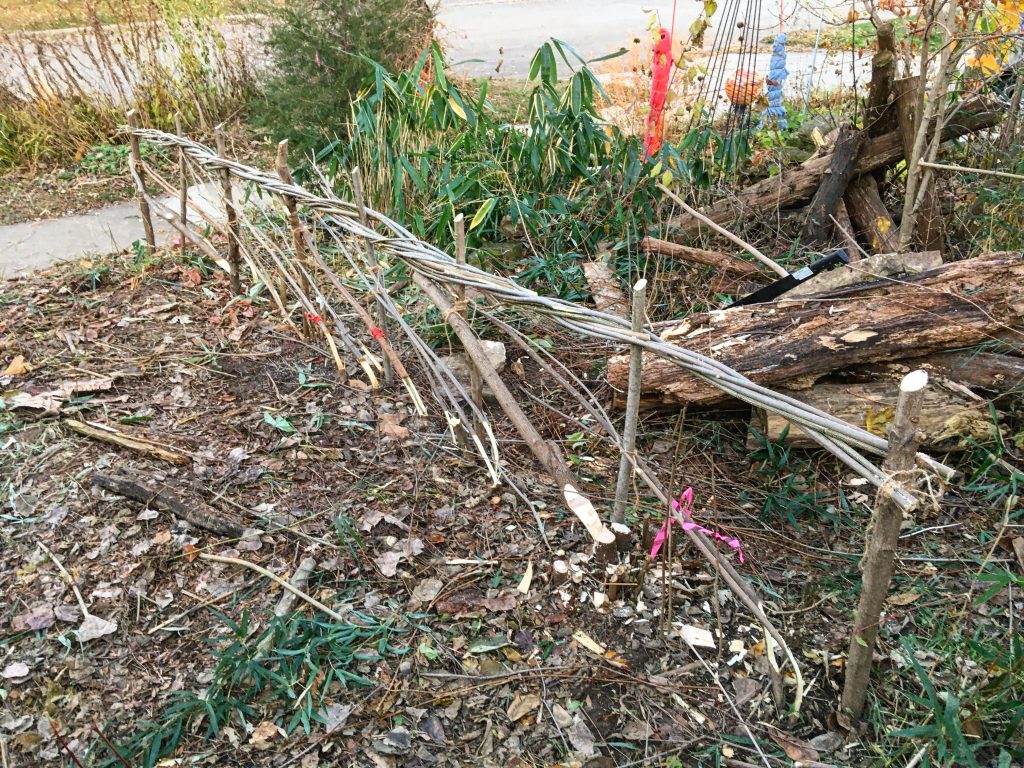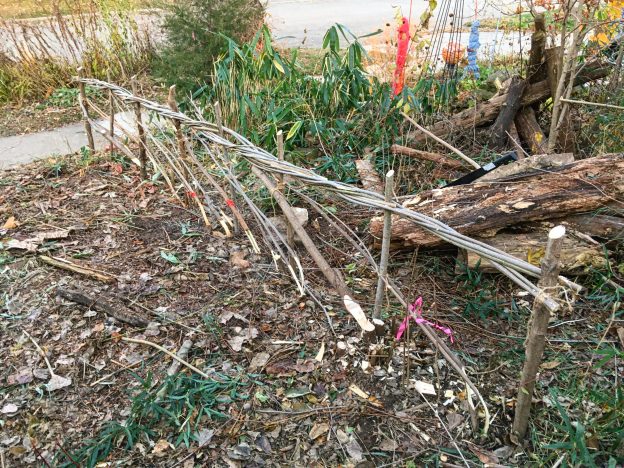In recent years, our region (Upper Midwest, United States) has benefitted from increasing awareness of native plants and their many benefits. However, while this region historically featured a rich tapestry of forest, woodland, wetland and aquatic plant communities, planting/restoration efforts have usually involved native herbaceous prairie grasses and forbs. Prairie species are indeed compelling choices for a native planting. Prairie restoration projects can help to reverse the near complete destruction of prairies as a consequence of agricultural and urban development. Prairie plants respond relatively fast, often maturing within just a couple of years to beautify the landscape with rich displays of flowers and foliage textures while also providing wildlife habitat and food sources.
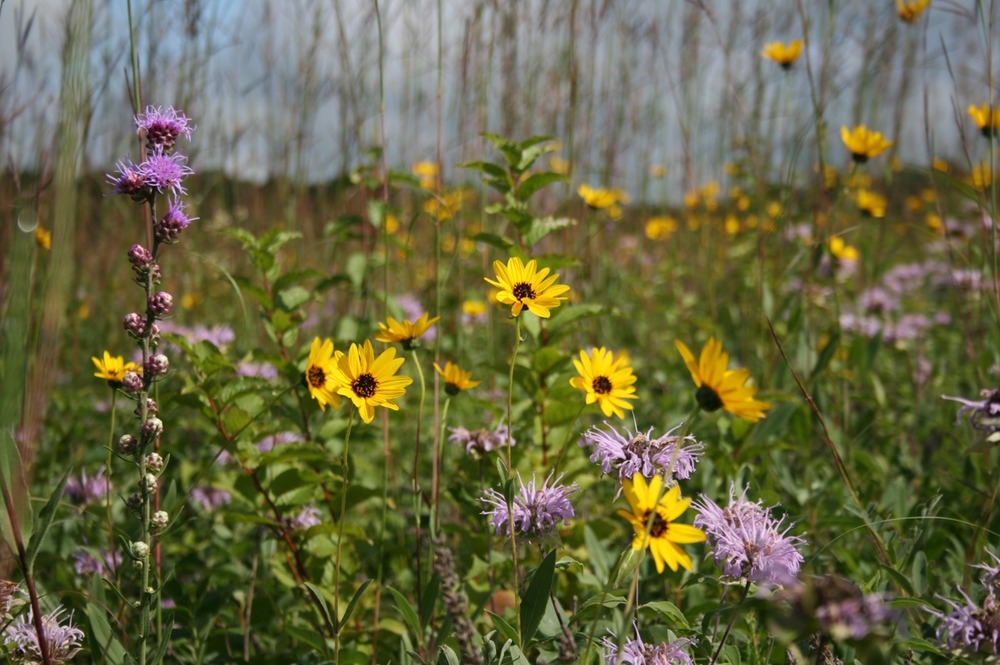
image.
Native woody plants, however, merit more recognition. Successive waves of introduced tree pathogens and pests have selectively killed off millions of forest canopy trees, an issue that may be addressed in part through planting of a wider diversity of native tree species. Land use changes have also tended to impede the natural reproduction of Oaks (Quercus spp.), the native trees arguably having the greatest ecological value. Native shrubs have likewise suffered from environmental change. Millions of acres of forest and woodland are severely degraded owing to the advance of non-native, invasive shrubs such as Common Buckthorn (Rhamnus cathartica), Amur Honeysuckle (Lonicera maackii) and Burning Bush (Euonymus alatus). Open areas and property boundaries in urban and suburban areas often come to be dominated by these invasive shrubs along with just a few weedy native trees, such as Boxelder (Acer negundo) and Black Walnut (Juglans nigra).
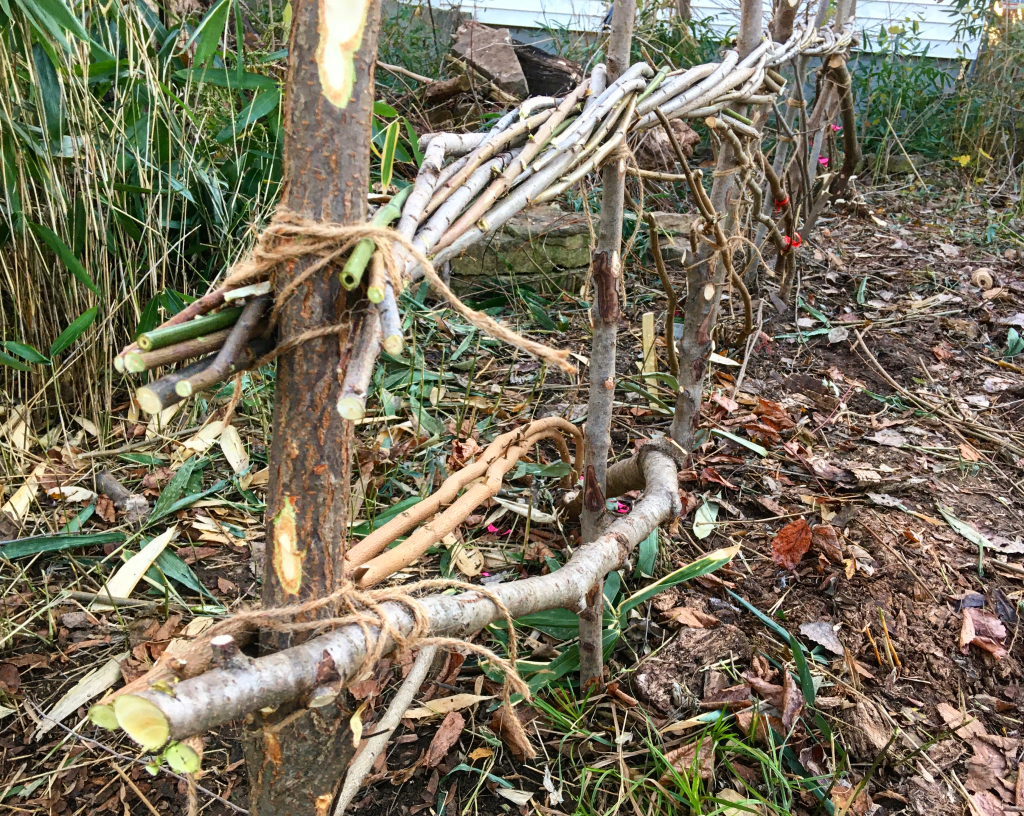
The following lists particularly compelling features of native shrubs as home garden and habitat restoration plant choices:
- Bird food sources – many native shrubs provide berries as food sources for birds and other wildlife. In some cases these small fruits on the plant well into the lean winter months (e.g. Highbush Cranberry [Viburnum trilobum]).
- Insect nectar and foliage hosts – some native shrubs (e.g. Viburnum spp. Cornus spp, Sambucus spp.) bloom with showy, often bright white, flower clusters in late spring or early summer that attract and support a wide variety of insect pollinators. Native shrubs also host a disproportionately high diversity of butterfly and moth (Lepidoptera) caterpillars as foliage food plants.
- Utilitarian/practical values – garden designers and landscapers have long planted lines of shrubs as privacy screens. With their ranges of forms, textures and colors they also have obvious value as garden foliage features. While shade trees can grow to large sizes making pruning or removal difficult and costly, a home gardener can usually manage even mature shrubs with just a few hand tools.
They grow on the other side of the Atlantic Ocean, but the traditional farmland hedgerows of Europe, particularly the United Kingdom, exemplify a marriage of the ecological, aesthetic and utilitarian attributes of shrubs and small trees. Employed mainly as livestock enclosures since the Bronze Age, or even earlier, some ancient hedgerows survive in use to this day and define the deeply historic scenery of areas such as Cornwall, England; Normandy, France and Tuscany, Italy. Many thousands of miles of very old British Isles hedges have fallen to the advance of urban development and agricultural intensification, but with the UK’s deep appreciation for history, culture and wildlife conservation, a great deal has been invested in protecting and restoring hedgerows. It is in fact unlawful to remove traditional hedgerows in the United Kingdom without special permission and landowners may apply for funds dedicated to their replanting and maintenance.
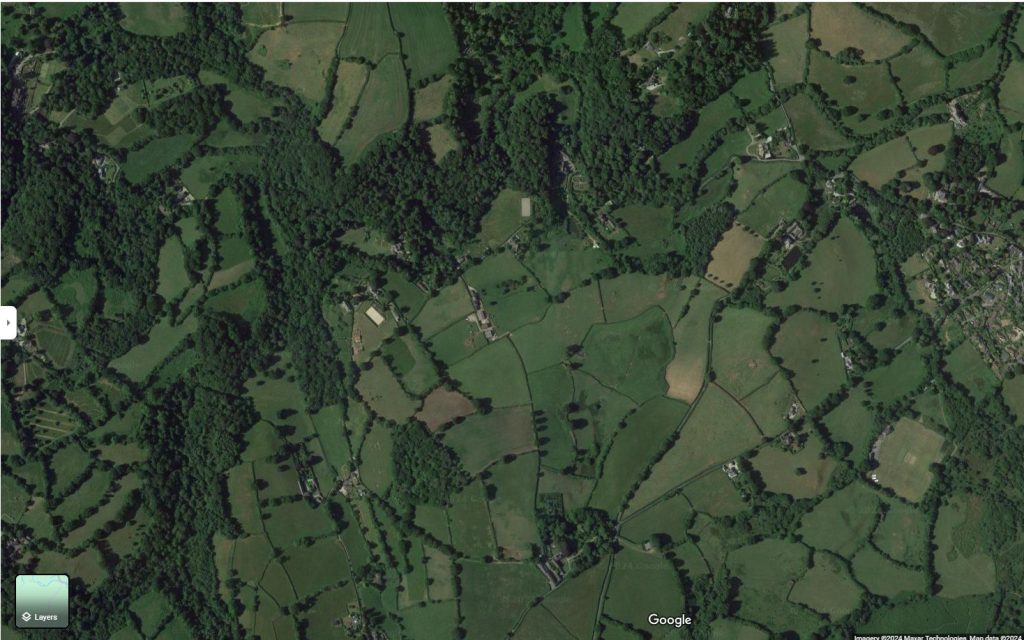
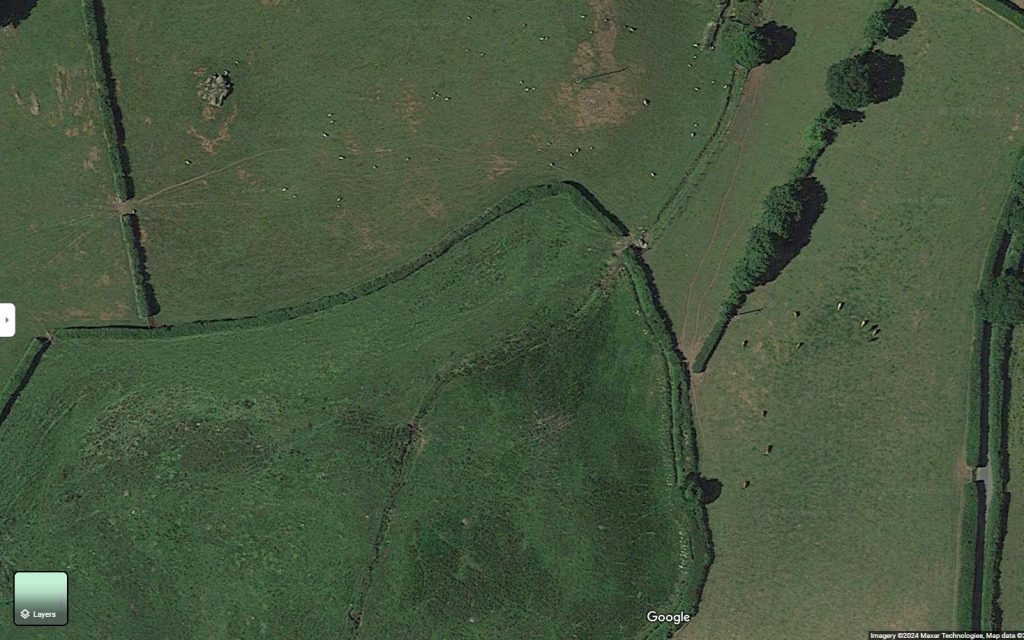
While maintaining the traditional, bucolic scenery of rural areas, the hedgerows of the UK also conserve a traditional art. Hedgelaying is the practice of restoring overgrown hedges as effective livestock barriers and wildlife habitat. In a laid hedge, the worker cuts part of the way through the bases of select larger stems, referred to as pleachers, so that they may bent over without breaking at an approximate 45-degree angle. As the job progresses, workers cut shrub and tree stem stakes, usually from the same hedge, to be sharpened and driven into the soil along the laid stems, thus securing them in place. Thinner, flexible stems may be cut from Willow (Salix spp.) or other species to be woven between the stakes as binders, further stiffening the whole structure. The work is completed in late fall or winter, during plant dormancy, and the partial cut through the laid stems preserves enough of the plants’ vascular tissue so that they can re-sprout in the springtime. Whereas the aging hedge may have previously had many gaps around the shrub stems and thinning foliage along the shaded lower branches. The sprouts emerging from the laid stems’ dormant buds expand as thick, vigorous new growth in the much brighter, full-sun conditions. Within a couple of seasons the dead stakes and binders begin to decompose and fall to the ground, but by that point many new shoots will have grown to create a dense living barrier. Incorporating some thorny shrub species, especially Hawthorn (Crataegus spp.) the hedge will come to be as impenetrable to Cattle, Horses and Sheep as barbed wire or electric fencing.
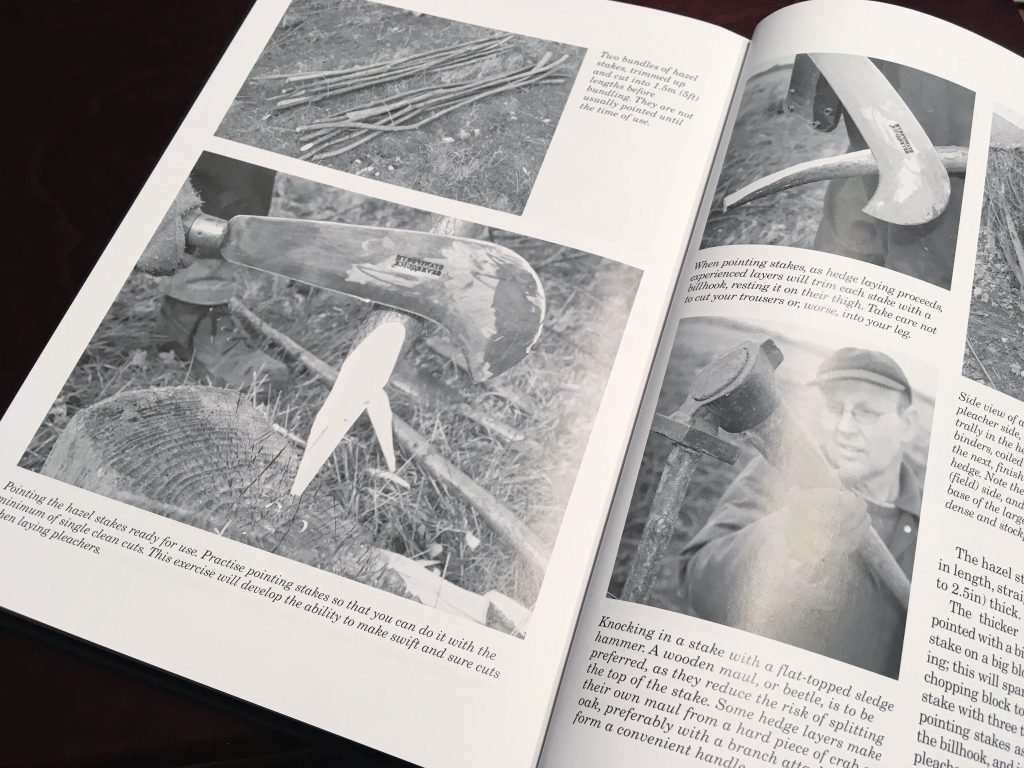
Hedgelaying thusly fulfills practical roles, while also conveying a harmony between the natural growth of living plants and human craftsmanship; being in this way akin to plant-training horticultural arts such as bonsai or espalier. This project began as I was reminded of the hedgerows of the United Kingdom during research into more general questions about native plants gardening. I was consequently inspired to attempt to create a laid hedge here in our home wildlife garden. Since I did not already have a planted, mature, multi-species hedge, I instead applied an alternative approach with a few compromises.
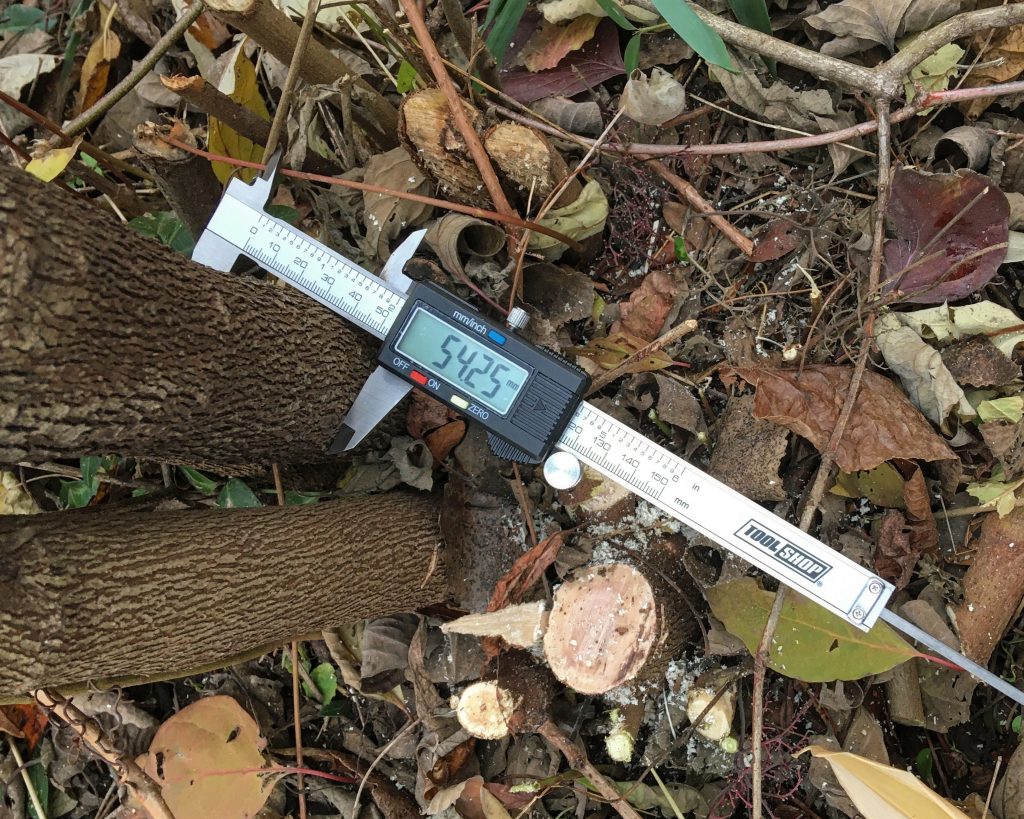
A quick garden survey identified two mature shrubs, a Common Witch-Hazel (Hamamelis virginiana) and a Silky Dogwood (Cornus amomum), growing in a line roughly parallel with the property boundary. These two plants had several stems each with the largest being more than 2 inches (50mm) in diameter at their bases, but there was about 10 feet (3m) of empty space between them. Since I was disinclined to wait 5-10 years for newly planted shrubs to grow, I instead filled the span with transplanted shrubs. United Kingdom farm hedges are planted on tight spacing, usually with just 9-18 inches (20-40cm) between seedlings. I initially situated the transplants about 18 inches (40cm) apart, but this spacing looked very thin with the spindly stems I was able to find growing elsewhere in the native garden. So I planted several more into the space. For better odds with transplant survival, I completed the work in late November as the plants entered their winter dormancy and almost all of their leaves had fallen. The following lists the species included along with observations on their garden use, ecology and hedge development:
- Amorpha fruticosa, False Indigo Bush – I planted this fine-foliage shrub from seed in another garden location about 5 years ago. As the garden’s only member of the Pea Family (Fabaceae) it is a potential caterpillar host plant for Silver-Spotted Skipper (Epargyreus clarus), Clouded Sulfur (Colias philodice) and Gray Hairstreak (Strymon melinus) butterflies. The stems of this plant were only about .4 inches (10mm) in diameter at the base and rather brittle. One snapped all the way through during my work, while the second was successfully laid.
- Calycanthus X ‘Aphrodite’ – As a cultivated, hybrid, non-native species, this would otherwise be a less than ideal selection for a wildlife hedgerow, but this shrub was growing close to the hedgerow project and required transplant anyway, so it was moved in line with the other plants. The tropical foliage, unique flowers and interesting evolutionary status of Calycanthus offer some botanical interest for the garden. Stems of this plant were too thin for traditional pleacher cuts, but were instead simply bent over at the same angle as the other shrubs.
- Cornus amomom, Silky Dogwood – This attractive, robust, clonal shrub supports a diversity of insect pollinators as well as larval insects. More than 100 species of butterfly and moth caterpillars host on the foliage including the Spring Azure (Celastrina ladon ladon).
- Crataegus sp., a Hawthorn – I do not have a definitive ID for this plant, although based on leaf shape it might be a Downy Hawthorn (Crataegus mollis). Two sapling-size clones were dug with rather limited root balls from beneath a mature small Hawthorn, but with luck they will survive the dormant-season transplant.
- Hamamelis virginiana, Common Witch-Hazel – This interesting species and one of our most characteristic native shrubs seems to have very good form and growth habit for hedge laying. The late fall to early winter blooms support late season pollinators, while dozens of Lepidoptera, including the Funerary Dagger Moth (Acronicta funeralis), host on the summer foliage.
- Rhus typhina, Staghorn Sumac – With brilliant red fall foliage and persistent bright berry clusters, this clonal shrub provides 4-season garden visual interest and wildlife food value. A wide variety of insects host on the foliage and the berries are important winter emergency food for many birds. Sumacs invest more in their root systems, while their stems are rather weak and pithy. The brittle stem of this single transplant almost snapped through, but there might be enough live tissue to support new shoots in the springtime.
- Salix exigua, Coyote Willow – Willows are excellent hedgerow selections. They respond very well to pruning and pruned branches serve as perfect hedge binders. Coyote Willow is a common, fast-growing plant obviously well-adapted to our conditions.
- Viburnum lentago, Nannyberry – Comparable to Cornus Dogwoods in bloom production and foliage host value, various native Viburnum species are easy to grow in the home garden.
- Zanthoxylum americanum, Prickly Ash – These small shrubs were transplanted from a wild stand. With the tops pruned, they stood only about 18 inches (45cm) tall and were thus too short for hedge laying, but I transplanted them into the line anyway. With aggressive, spreading tendencies, stout thorns and a spindly growth habit, Prickly Ash is not usually considered to be a desirable garden shrub. But as a member of the Citrus Family (Rutaceae) it is a botanically interesting plant and caterpillar host for North America’s largest butterfly, the Giant Swallowtail (Papilio cresphontes).
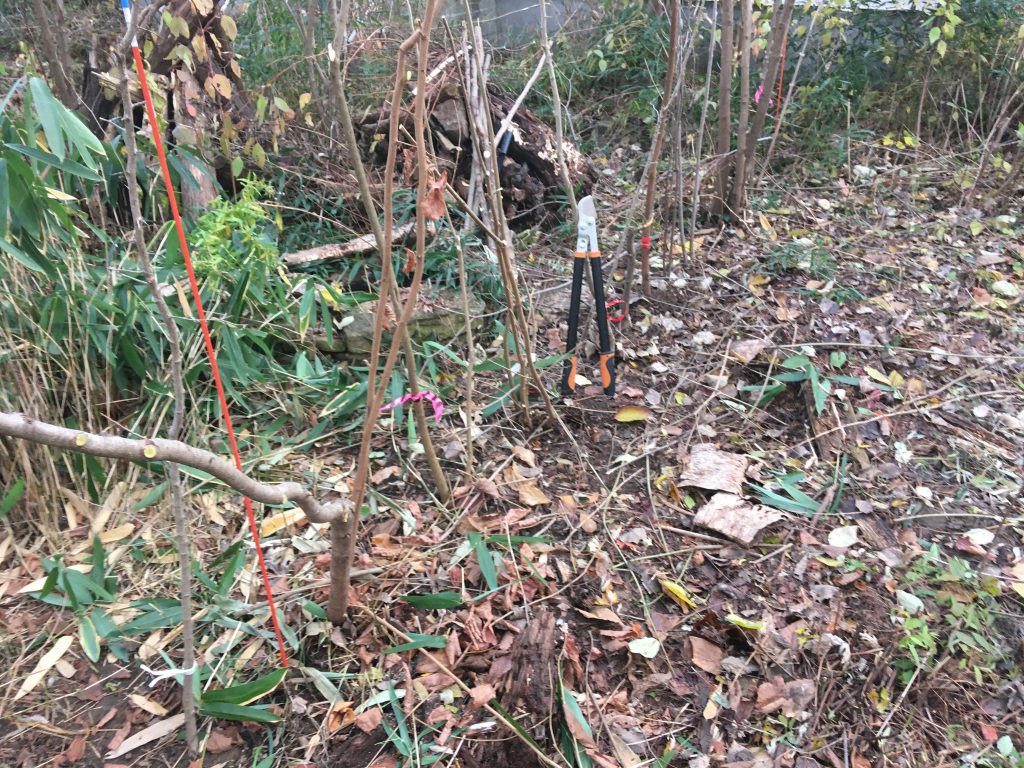
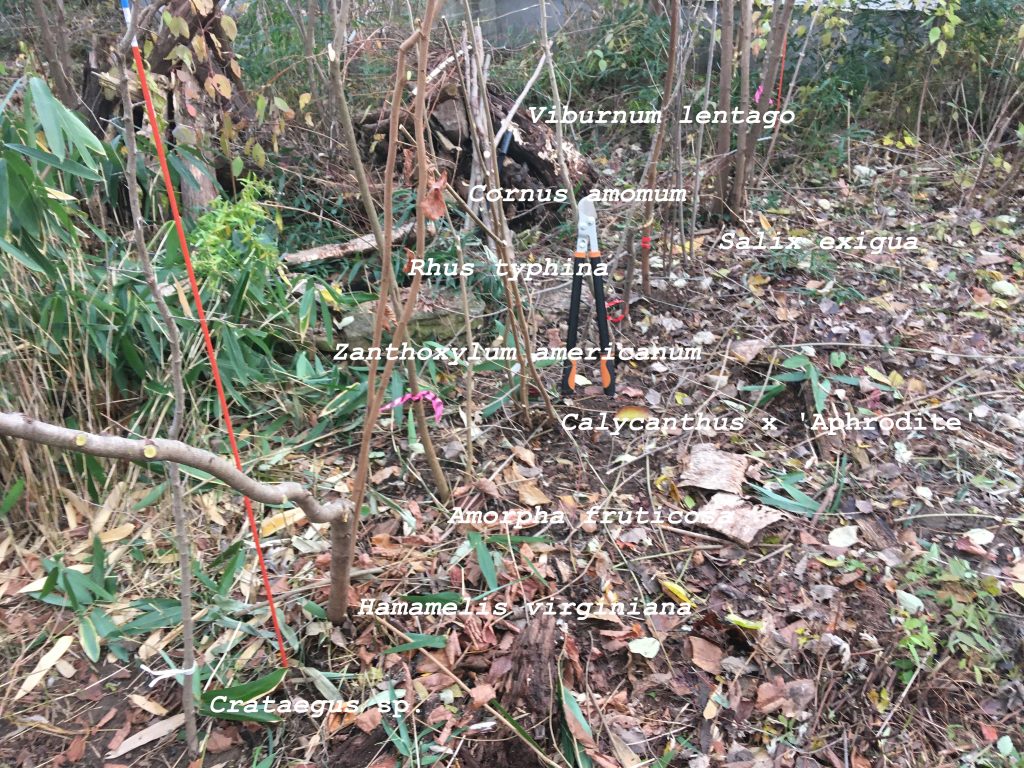
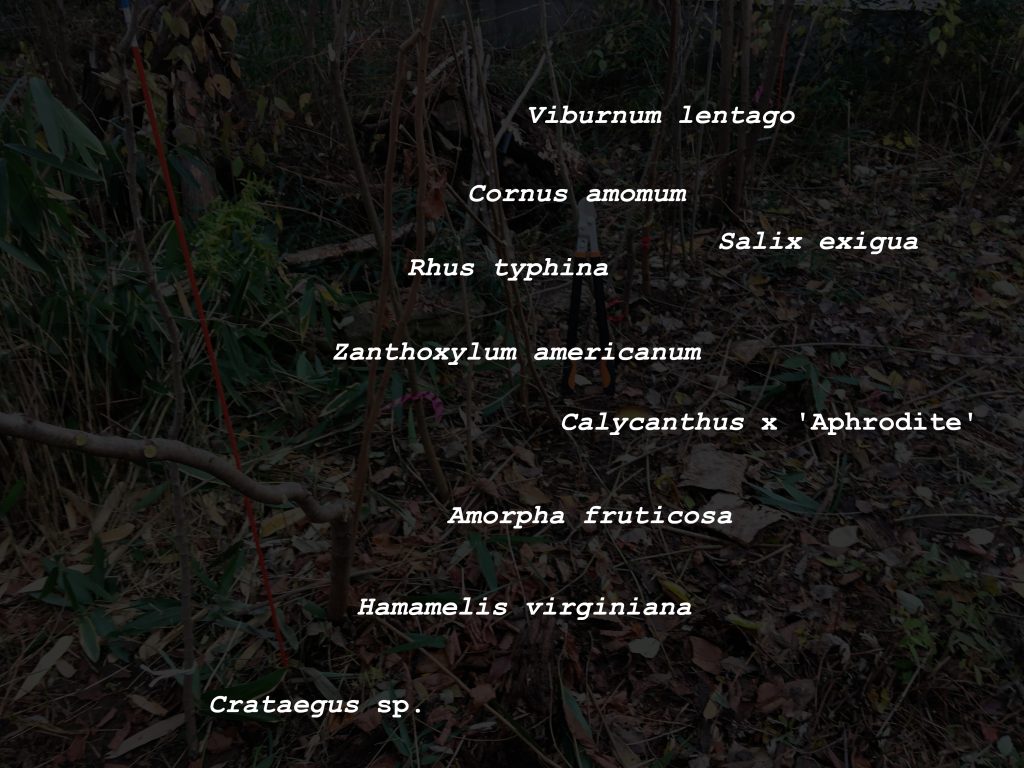
The existing and transplanted shrubs were in a straight line only about 14 feet (4.25m), but the hedgelaying job required several hours of work to complete. After transplanting and clearing adjacent growth, I cut each pleacher at a height of 60 inches (150cm) from the ground. Traditional hedge laying guidance recommends laying pleachers at a 45-degree angle, but since I had a sparse arrangement of stems, I decided to bend them closer to the ground at about 30 degrees from horizontal for more overlap. Hedge layers usually use a sharp bill hook blade to chop clean, angled cuts through pleachers. I was unpracticed, however, and worried about cutting through too much wood, so I instead used a folding hand saw to start the pleacher cuts. For thinner stems I was able to then open the cut and enlarge the split with a bill hook, but on the largest Witch Hazel and Dogwood pleachers I made a pair of saw cuts to open space for the bill hook. Bending of the pleacher left the remaining vertical stem material as a heel, which I then cut off nearly flush with the soil surface using the folding saw.
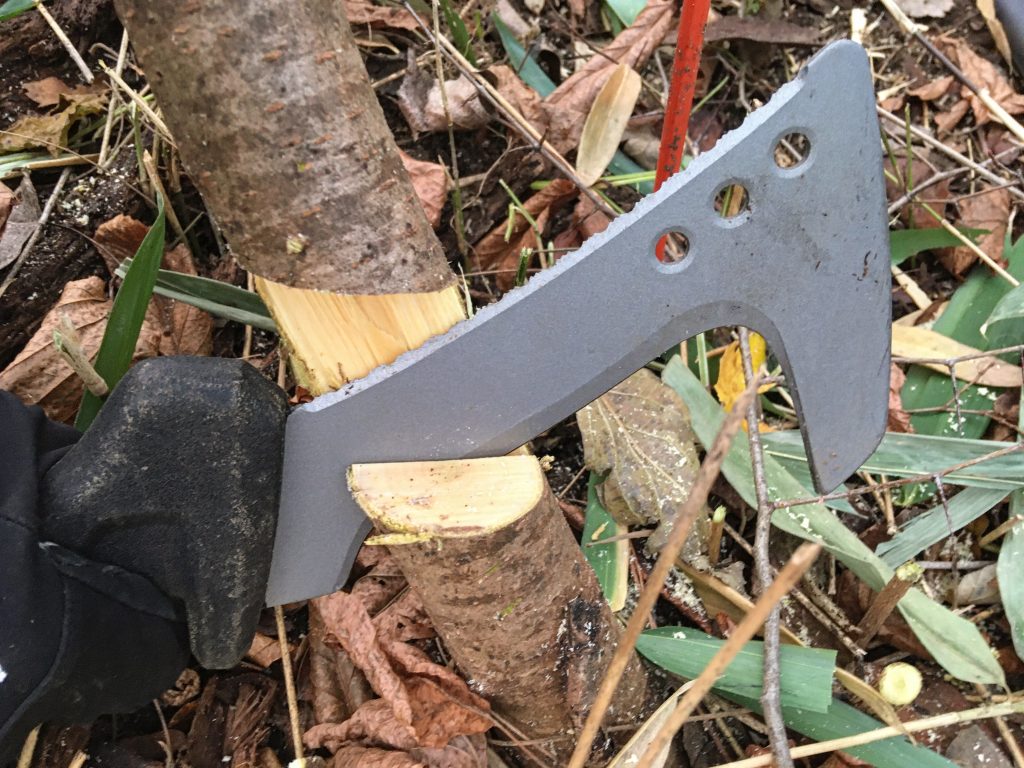
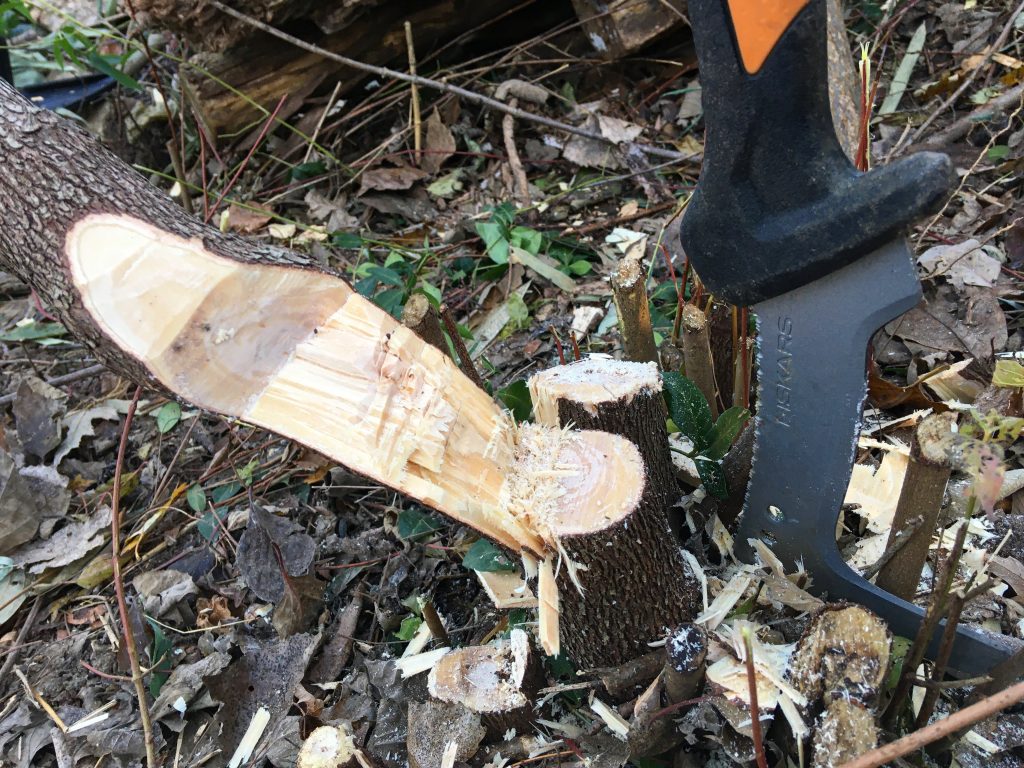
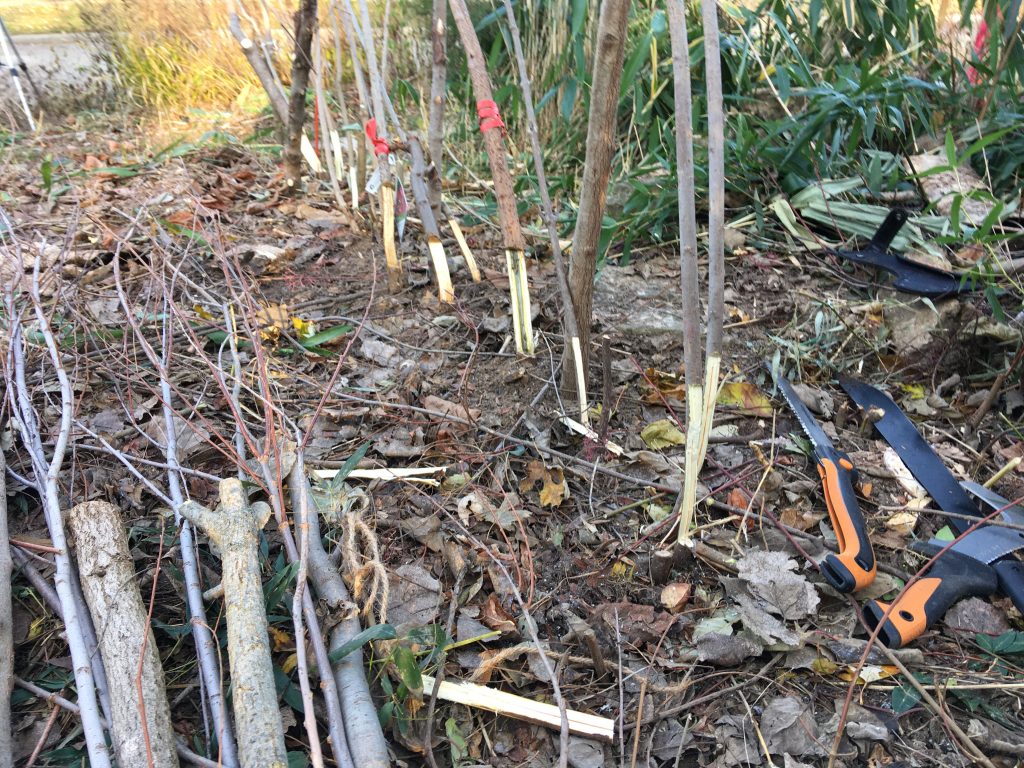
As the pleacher laying progressed, I drove stakes into the ground to provisionally secure the stems and prevent additional breakage. Stakes were then pulled out and repositioned in a straight line with even 24-inch (50cm) spacing. A few wraps of jute twine joined the pleachers and the stakes. I could use more practice to achieve tight, consistent results, but the Willow branch binding was the most satisfying step of the process. The two strands of flexible binders bent around each other with a complete twist between each of the stakes. Willow branches averaged only about 5 feet (1.5m) long, so I inserted several new ones to maintain more or less consistent strand thickness down the length of the laid hedge.
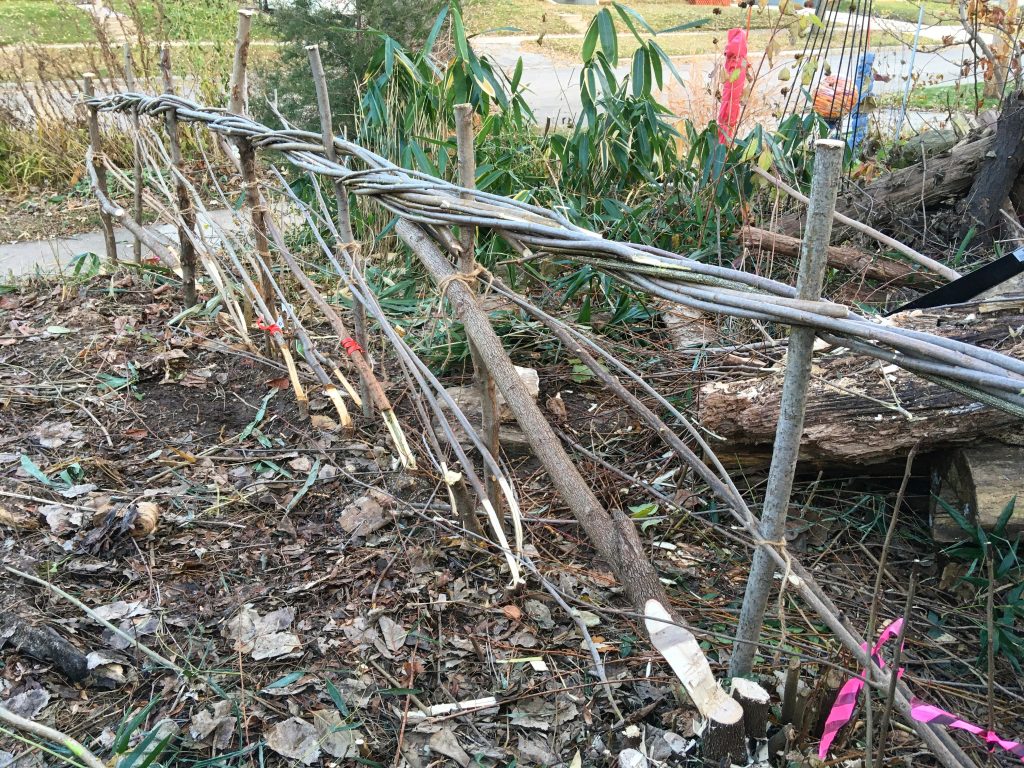
The final step was to even the heights of all stakes with 45-degree folding saw cuts. If most of these pleacher stems survive the winter to resprout in the springtime, they will grow to form a dense, multispecies hedge. In our North American context, hedglelaying probably has limited utilitarian value, but borrowing from this agricultural tradition suggests a uniquely artistic option for gardening with native shrubs and small trees.
